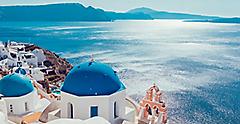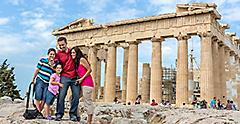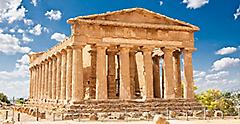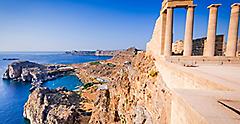
Sun-Seeking In Santorini
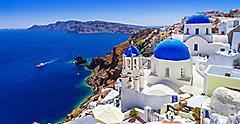
Island Hopping To Santorini
Santorini is one of the best-known destinations in the region and a fixture on any Greek island itinerary. As a favorite among honeymooners and sun-seekers, it totally lives up to the hype. Sure, it sees its fair share of tourists during peak season, but there are plenty of ways to dodge the crowds. I rented a scooter and zipped off to explore the island's quaint cliffside villages with their cozy al fresco cafes, sun-kissed vineyards and the wonderfully preserved ruins of Akrotiri first thing in the morning. Then, I spent my afternoon unwinding at a beach club on a black sand beach. You'll find several throughout the island that feel a world away from the bustling cobblestone streets of towns like Oia and Fira. In fact, less than eight miles northeast of the island's capital, there's Cape Columbo, Santorini's most off-the-beaten-path beach. Hemmed by towering black and white cliffs, the dramatic landscape of this wild, wind-lashed shoreline is truly awe-inspiring.
If you're a wine lover, no visit to Santorini is complete without checking out one of the island's many vineyards. The island is well known internationally for its Vinsanto wines, made from late-harvest, sun-dried white grapes that have been aged in oak for at least two years. Most wineries on the island offer tours and tastings.
Zip Through Mykonos By Boat

Island Hopping To Mykonos
Mykonos, another of Greece's most famous islands to visit, has earned a reputation as a party island getaway. True, you'll find no shortage of beat-thumping, celebrity-frequented beach clubs near Ornos, Paraga and Paradise Beach, as well as vibrant nightlife in Mykonos Town. Though you can also find plenty of sun-kissed rest and relaxation. Ftelia, Kapari, Fokos and Mersini are some of Mykonos's quieter, more secluded beaches. Since the island has very few taxis, and they're all in demand during the busy summer months, consider splurging and chartering a boat during your time in Mykonos. I chartered a sailboat with a captain for the whole day and quickly found it's the most convenient way to get to the island's quieter beaches and hidden coves. The captain regaled me with stories of each location's history and offered insider tips on where to eat and party on the island — a priceless bonus.
If you're a history lover, you should definitely pencil in an excursion to the nearby island of Delos. In ancient times, Delos was believed to be the birthplace of the Greek goddess Artemis and the god Apollo and served as the region's holiest and most important island. Today, it's home to a UNESCO World Heritage Site that's considered one of Greece's most significant and best-preserved archeological wonders. Visitors can explore the ruins of Greek, Roman, Syrian and Egyptian shrines dating back thousands of years before heading back to Mykonos by boat or ferry.
Rhodes Leads To Ancient History And Beautiful Beaches

Island Hopping To Rhodes
As a fixture on most Greek island cruises, Rhodes brims with just as much ancient history and beautiful beaches as its more popular neighbors to the west, like Santorini and Mykonos. It's home to an impressive acropolis that dates back to the fifth century BC and includes the Temple of Apollo, a well-preserved stadium and theater. Around the acropolis sprawls the city of Rhodes itself, encompassing one of Europe's preserved medieval walled cities with standout sites such as the mosaic-studded Palace of the Grandmaster. This was my first stop during my visit. I started my day with a leisurely stroll along the city's ancient streets and squares before ducking into a local taverna for some Greek coffee and a slice of flaky baklava.
Then I made a bee-line for a daybed on Lindos Beach, one of the island's most beloved stretches of shoreline. Located walking distance from the charming village of Lindos, it had plenty of sunbeds and umbrellas available for rent, as well as water sports and a great selection of shoreside tavernas. The acropolis dominates the skyline in the distance, providing a truly wow-worthy backdrop for photos. For a more secluded experience, head to Prassonissi Beach, known as one of the island's best spots for windsurfing.
Kick Off Your Travels In Crete
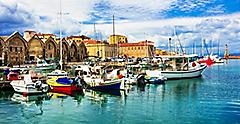
Island Hopping To Crete
Far to the west of Rhodes and surrounded by the jewel-bright waters of the Mediterranean Sea sits lovely Crete. While my cruise didn't include a stop here, fellow travelers have advised me that the best place to kick off your visit is at the Venetian Harbor, where the mouthwatering scent of grilled seafood, dried mountain herbs and fragrant spices lead you down the city's narrow, winding streets to bustling tavernas serving lightly fried sfakia pies made with thyme-infused honey and locally sourced cheese. Once you've fueled up for a day of exploration, head to Knossos — a 3,000-year-old palace about a two-hour drive west of Chania port. According to Greek mythology, the legendary King Minos built a labyrinth here to imprison Queen Pasiphae's son, the Minotaur.
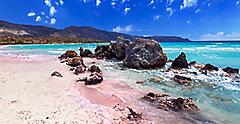
Uncover All There Is To Corfu

Island Hopping To Corfu
While Greece's Aegean islands are well known as top vacation getaway destinations around the world, Corfu is somewhat less recognized among today's international jet-set. It's astounding that it's managed to fly under the radar for so long — especially considering it's one of the region's most romantic destinations. Located on the opposite side of the mainland in the Ionian Sea, this large island represents a quieter, more idyllic alternative to its well-trod sister isles east of the Athenian Riviera. You'll see evidence of its centuries under Venetian rule in its pastel-colored Italianate architecture, which clashes whimsically with its massive fortresses and quiet fishing villages.
About 30 minutes from Corfu, you'll find the beautiful village of Paleokastritsa, home to a historic monastery, lots of restaurants serving up fresh-caught seafood and some of the country's top-rated beaches. There's also the Achilleion Palace, built in the late 19th century for an Austrian Empress, filled with restored frescoes, perfectly manicured gardens and statues of Greek gods including Hera and Zeus. For some retail therapy in between onshore discoveries, visit Corfu's charming Old Town. The shops that line its streets sell everything from kitschy souvenirs to stunning porcelain vases, painted seashells and more. And whatever you do, don't leave without purchasing some of the island's famous handmade olive soap to bring home with you.
Carefree In Cephalonia
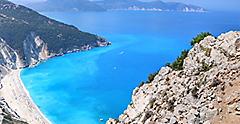
Island Hopping To Cephalonia
South of Corfu sits Cephalonia — another Ionian stunner and a great destination to add to your next Greek island hopping escape. Spend some time in Argostoli, the island's capital, where life tends to move at a slow, carefree pace. The most popular things to do involve exploring the island's natural wonders — such as Koutavos Lagoon, a lush nature reserve situated at the head of Argostoli Bay. It's teeming with all kinds of interesting wildlife, including the Caretta Caretta turtle. You can wander through the preserve's shady eucalyptus and pine forests for a glimpse of the many birds that make their homes among the branches. There's also towering Mount Ainos, the island's tallest peak. Head to the summit in a jeep or hike among its fragrant black pine forests and try to spot the semi-wild ponies that wander and graze among the trees. On a clear day, you can glimpse the islands of Zakynthos, Ithaca and Lefkada from the top.
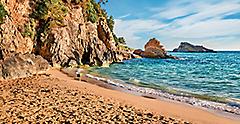
Get Royal Deals, Sign Up Today




